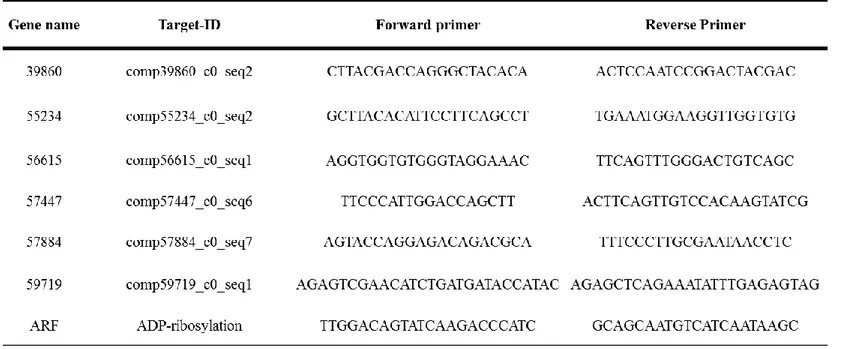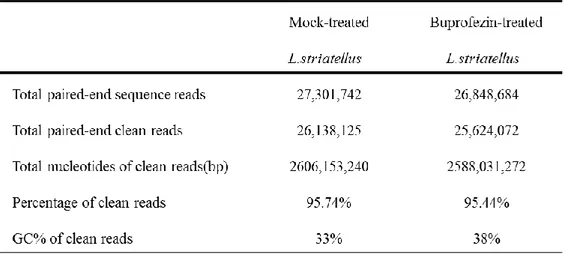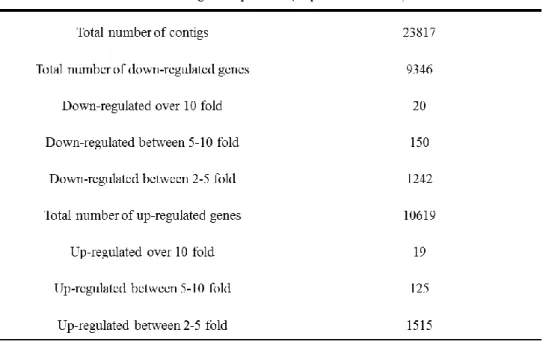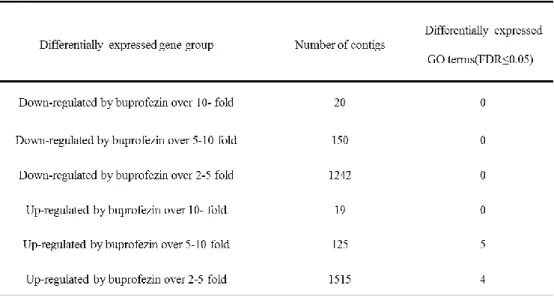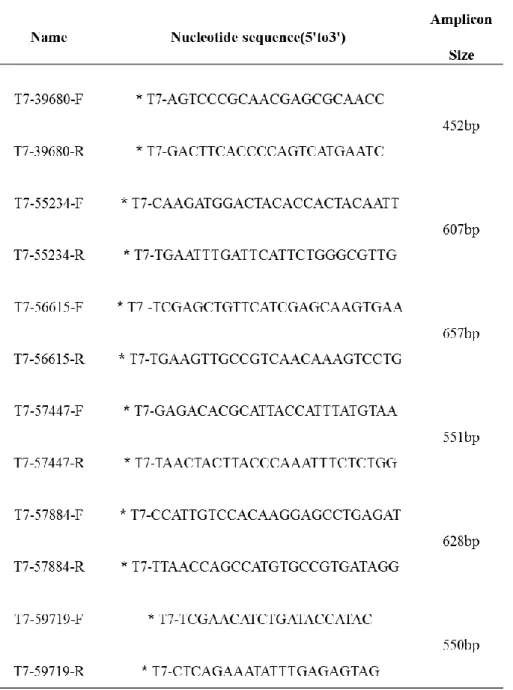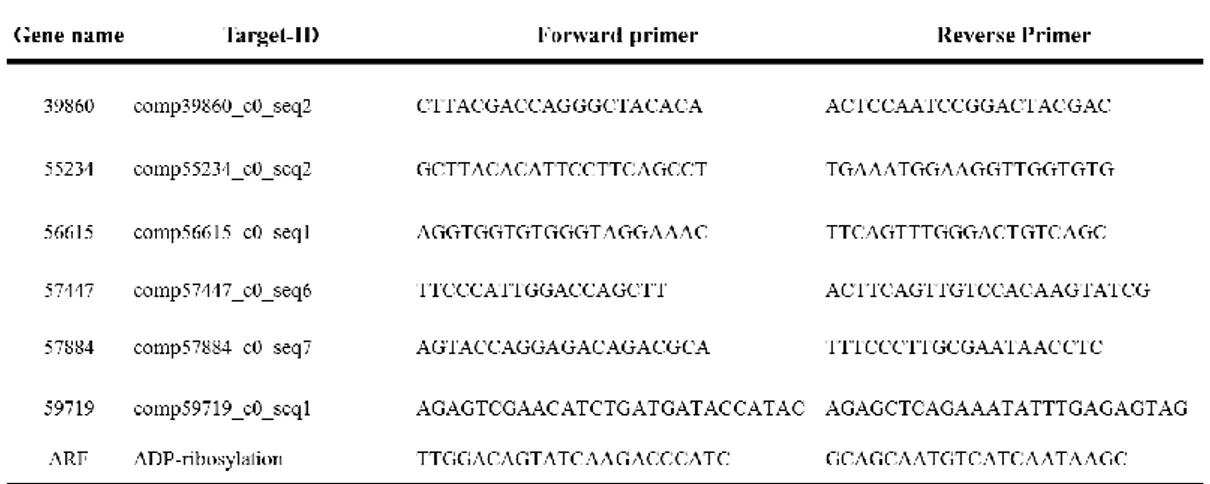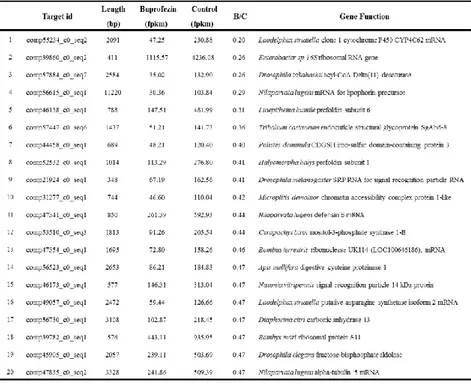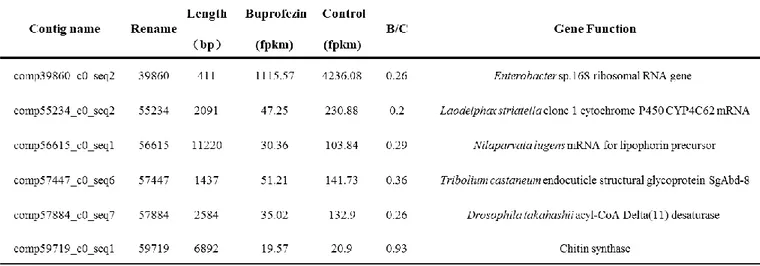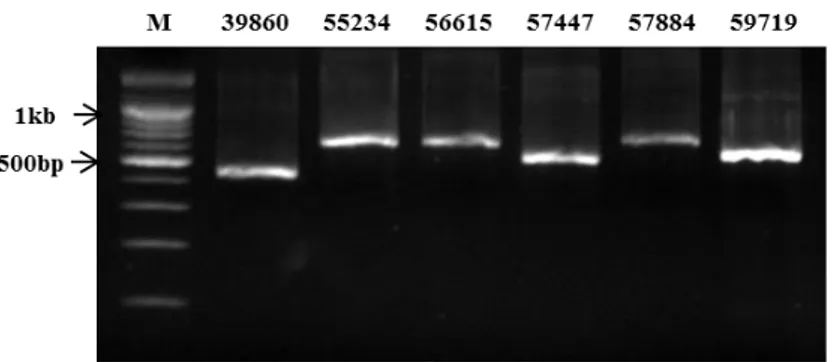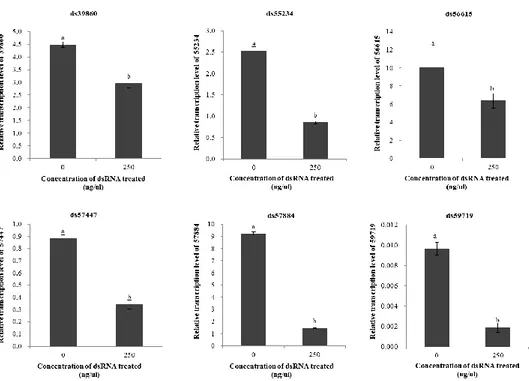저작자표시-비영리-변경금지 2.0 대한민국 이용자는 아래의 조건을 따르는 경우에 한하여 자유롭게 l 이 저작물을 복제, 배포, 전송, 전시, 공연 및 방송할 수 있습니다. 다음과 같은 조건을 따라야 합니다: l 귀하는, 이 저작물의 재이용이나 배포의 경우, 이 저작물에 적용된 이용허락조건 을 명확하게 나타내어야 합니다. l 저작권자로부터 별도의 허가를 받으면 이러한 조건들은 적용되지 않습니다. 저작권법에 따른 이용자의 권리는 위의 내용에 의하여 영향을 받지 않습니다. 이것은 이용허락규약(Legal Code)을 이해하기 쉽게 요약한 것입니다. Disclaimer 저작자표시. 귀하는 원저작자를 표시하여야 합니다. 비영리. 귀하는 이 저작물을 영리 목적으로 이용할 수 없습니다. 변경금지. 귀하는 이 저작물을 개작, 변형 또는 가공할 수 없습니다.
A THESIS
FOR THE DEGREE OF DOCTOR OF PHILOSOPHY
Transcriptomic analysis of useful genes applicable
for RNAi-based control of the small brown
planthopper and rice stripe virus
전사체 분석을 통한 유용 유전자의 RNAi 를 활용한
애멸구 및 벼줄무늬잎마름바이러스의 방제
By
Ying Fang
Major in Entomology
Department of Agricultural Biotechnology
Seoul National University
Transcriptomic analysis of useful genes applicable for RNAi-
based control of the small brown planthopper and rice stripe virus
UNDER THE DIRECTION OF ADVISER YEON HO JE
SUBMITTED TO THE FACULTY OF THE GRADUATE SCHOOL OF SEOUL NATIONAL UNIVERSITY
By Ying Fang
Major in Entomology
Department of Agricultural Biotechnology Seoul National University
February, 2018
APPROVED AS A QUALIFIED DISSERTATION OF YING FANG FOR THE DEGREE OF DOCTOR OF PHILOSOPHY
BY THE COMMITTEE MEMBERS
CHAIRMAN Joon Ho Lee ___________________
VICE CHAIRMAN Yeon Ho Je ___________________
MEMBER Si Hyeock Lee __________________
MEMBER Byung Rae Jin ___________________
i
Transcriptomic analysis of useful genes applicable for RNAi-
based control of the small brown planthopper and rice stripe
virus
Major in Entomology
Department of Agricultural Biotechnology, Seoul National University
Ying Fang
February, 2018
ABSTRACT
The small brown planthopper (SBPH), Laodelphax striatellus (Fallén), is an economically important phytophagous species in the family of Delphacidae of Hemiptera. It has a wide distribution range from south-east Asia to Siberia and Europe, and attacks several important agricultural crops including rice, corn, wheat, oat and barley. SBPH is one of the most serious pest insects of rice plants because it transmits the rice stripe virus (RSV) in a circulative-propagative manner which typical symptoms include pale and
ii
discontinuous yellow stripes, blotches and dead tissue streaks on the leaves. Chemical insecticides have been used to this economic pest for several decades.
Buprofezin is an insect growth regulator (IGR) pesticide which is active against larval stages to cause cuticular lesions that result in the disruption of chitin synthesis. Because this insecticide has generally been considered to have a good efficacy against the target pests while being harmless to beneficial insects, it has been used widely in integrated pest management programs especially used in the control of homopteran pests. As buprofezin used to control L. striatellus for more than a decade, the buprofezin resistant occurrence of
L. striatellus was reported recently.
To survey the responses of SBPH to buprofezin, transcriptome analysis of buprofezin treated SBPH had been investigated. 200ppm buprofezin was exposed to 4th instar SBPH by the dipping method, and extracted total RNA for RNA-seq by Illumina platform. Total of 2 x 26,848,684 and 2 x 27,310,742 of 101 base paired-end raw reads were obtained from buprofezin treated SBPH and control samples, respectively. The cDNA library containing 23,817 contigs was constructed by Trinity de novo assembler and TransDecoder ORF finder. The quality filtered raw reads from experimental and control SBPH were subjected to the library with Bowtie2 and eXpress computer programs to obtain the differential gene expression profile. Following analysis revealed that 170 and 144 contigs were down- and up-regulated over five-folds in the buprofezin treated samples, respectively. GO (gene ontology) enrichment analysis were subjected to study the changes of gene expression profile. Total of 9 GO terms showed differential expression under buprofezin treatment. These transcriptome and gene expression
iii
profiling date will provide important information for future studies of molecular biology and physiology of L. striatellus.
To develop an alternative pest control strategy, six buprofezin-specific genes selected by differential expressed genes from RNA-seq of buprofezin-treated L. striatellus were synthesized to dsRNAs, and applied to L. striatellus to assess the insecticidal efficacy. Two and three of those dsRNAs showed moderated and substantial insecticidal activity up to 60% of mortality in 7 days post treatment, respectively. These results demonstrated the potential of gene screening strategy for the development of RNAi-based pest management program. RNA interference (RNAi) was not only suggested as a promising strategy for controlling insect pests, but also affects the transmission of plant pathogens of insects. To disturb transmission of the RSV in SBPH by using RNAi pathway, we chose nine genes highly expressed in RSV-viruliferous SBPH by transcriptome sequencing. These SBPH-derived dsRNAs were applied to the insects indirectly through xylem of rice leaves by irrigation. qPCR result demonstrated that three out of eight SBPH-derived dsRNAs successfully reduced the replication of RSV in viruliferous SBPH in dose-dependent manner, suggesting that these three dsRNAs could suppress replication of RSV and provide a new tool for RSV control strategy.
In summary, an effective high-throughput NGS method largely broadens the target selection of specific RNAi genes from the non-model pest L.striatellus. It may lead to new strategy in designing the RNAi-based technology against SBPH damage and rice stripe virus transmission by L.striatellus.
iv
Key words:Rice stripe virus, Laodelphax striatellus, buprofezin, RNA-seq, RNA
interference, double-stranded RNA
v
CONTENTS
ABSTRACT ... i CONTENTS ... v LIST OF TABLES ... ix LIST OF FIGURES ... xLITERATURE REVIEW ... xii
1. Basic biology of Laodelphax striatellus ... xii
2. General characteristics of Rice Stripe Virus ... xiv
3. RNA-Sequencing ... xv
4. RNA interference ... xvi
CHAPTER 1. The transcriptomic responses of small brown planthopper, Laodelphax striatellus upon buprofezin treatement ... 1
ABSTRACT ... 1
1. INTRODUCTION ... 3
2. MATERIALS AND METHODS ... 7
2.1 Insect rearing and buprofezin treatment ... 7
2.2 RNA extraction ... 7
2.3 cDNA synthesis, sequencing and data analysis of RNA-Seq ... 8
2.4 Validation of sequencing result by qPCR ... 10
vi
3.1 Illumina sequencing ... 12
3.2 Characterization of the de novo assembled in silico cDNA library of L. striatellus ... 14
3.3 Analysis of differentially expressed genes upon buprofezin treatment ... 17
3.4 Validation of the sequencing results by qPCR ... 22
4. DISSCUSSION ... 24
CHAPTER 2. RNA interference for insecticidal activity in Small Brown Planthopper, Laodelphax striatellus by using dsRNAs targeting buprofezin-specific genes ... 28
ABSTRACT ... 28
1. INTRODUCTION ... 29
2. MATERIALS AND METHODS ... 32
2.1 Selection of genes for RNAi ... 32
2.2 Total RNA extraction and target gene cloning ... 32
2.3 dsRNA synthesis ... 33
2.4 Delivery of dsRNA to L. striatellus and Insect bioassay ... 36
2.5 Quantitative PCR analysis of knock down ... 37
3. RESULT ... 40
3.1 Selection of genes for RNAi ... 40
3.2 The confirmation of synthesized dsRNA ... 43
3.3 Silencing of candidate genes in L. striatellus ingested buprofezin-specific dsRNAs ... 43
vii
3.4 Silencing of buprofezin-specific genes by dsRNA causing increased
mortality ... 47
4. DISSCUSSION ... 56
CHAPTER 3. Silencing of rice stripe virus in Laodelphax striatellus... 62
using SBPH-derived double-stranded RNAs ... 62
Abstract ... 62
1. Introduction ... 64
2. Materials and methods ... 67
2.1 Insect culture and inoculation of RSV to non-viruliferous SBPH ... 67
2.2 Target gene design from SBPH genes ... 67
2.3 Total RNA extraction and target gene cloning ... 69
2.4 dsRNA synthesis and quantification ... 71
2.5 Delivery of dsRNA via O. sativa leaves ... 71
2.6 Assessment of gene knockdown ... 72
3. Result ... 74
3.1 Establishment of RSV-viruliferous SBPH ... 74
3.2 Selection of the up-regulated genes in RSV-viruliferous SBPH for dsRNA synthesis ... 76
3.3 Validation of the sequencing results by qPCR ... 76
viii
3.5 Reduced replication of RSV in L. striatellus ingested SBPH-derived
dsRNAs ... 84
4. DISSCUSSION ... 89
LITERATURE CITED ... 94
ABSTRACT IN KOREAN ... 114
ix
LIST OF TABLES
Table 1. Oligonucleotide sequences used for quantitative real-time PCR. ... 11
Table 2. Summary of the Illumina sequencing. ... 13
Table 3. Summary of differentially expressed contigs under buprofezin treatments.19 Table 4. Gene ontology enrichment analysis of differentially expressed gene groups under buprofezin treatment. ... 20
Table 5. Primer information for RT-PCR of candidate dsRNA ... 35
Table 6. Primer used in qPCR ... 39
Table 7. The list of down-regulated genes upon buprofezin treatment. ... 41
Table 8. The list of selected buprofezin-specific genes upon buprofezin treatment. . 42
Table 9. Primer information of candidate dsRNA reducing RSV. ... 70
Table 10. Primer sequences used for qPCR. ... 73
Table 11. The list of selected up-regulated genes in RSV-viruliferous SBPH ... 78
Table 12. The transcription patten of selected genes from reported paper ... 79
Table 13. List of eight selected genes for dsRNA synthesis to suppress RSV replication in SBPH... 81
x
LIST OF FIGURES
Fig. 1. Length distributions of the de novo assembled cDNA library of L. striatellus.15
Fig. 2. Gene ontology classification of L. striatellus cDNA library. ... 16
Fig. 3. Functional clustering based on Gene Ontology of genes. ... 21
Fig. 4. Validation of the Illumina sequencing result by qPCR. ... 23
Fig. 5. Agarose gel confirmation of synthesized dsRNA. ... 45
Fig. 6. Silencing of candidate genes in L. striatellus ingested buprofezin-specific dsRNAs. ... 46
Fig. 7. The mortality of L. striatellus at 7 days post treatment of single buprofezin-specific dsRNA treatment. ... 49
Fig. 8. The mortality of L. striatellus at 7 days post treatment of dsRNA cocktail containing five buprofezin-specific dsRNA. ... 50
Fig. 9. The mortality of L. striatellus at 7 days post treatment of dsRNA cocktail containing three buprofezin-specific dsRNA. ... 51
Fig. 10. The mortality of L. striatellus at 7 days post treatment of dose-dependent buprofezin-specific dsRNA treatment. ... 52
Fig. 11. The mortality of L. striatellus at 7 days post treatment of dose-dependent buprofezin-specific dsRNA cocktail treatment. ... 53
xi
Fig. 12. The mortality of L. striatellus at 72 h treatment upon dose-dependent concentration buprofezin by dipping method. ... 54 Fig. 13. The mortality of the L. striatellus at 72 h treatment under buprofezin-specific dsRNA cocktail treatment after buprofezin dipping treated previously. ... 55 Fig. 14. RSV confirmation of L. striatellus by RT-PCR analysis. ... 75 Fig. 15. Validation of the Illumina sequencing result by qPCR in RSV-viruliferous (RVL) and Non-viruliferous (NVL) SBPH. ... 80 Fig. 16. Silencing of candidate genes of L. striatellus ingested SBPH-derived dsRNAs. ... 83 Fig. 17. Suppression of RSV replication in RSV-viruliferous SBPH ingested with SBPH-derived dsRNAs. ... 86 Fig. 18. Suppression of RSV replication in RSV-viruliferous SBPH ingested with selected SBPH-derived dsRNAs. ... 87 Fig. 19. Dose-dependent suppression of RSV replication in RSV-viruliferous SBPH ingested with selected SBPH-derived dsRNAs. ... 88
xii
LITERATURE REVIEW
1. Basic biology of Laodelphax striatellus
Laodelphax striatellus (Fallén) (small brown planthopper, SBPH), Nilaparvata lugens
(Stål) (brown planthopper, BPH), and Sogatella furcifera (Horvath) (whitebacked planthopper, WBPH) have become major pests successively in the rice-growing areas of Asia and extensive studies have been carried out to develop control programs since the 1960s.
The small brown planthopper, Laodelphax striatellus (Fallén) (Hemiptera:Delphacidae) is one of the most important pests that causes virus disease to rice paddy fields by transmitting the plant-pathogenic virus. It is known to transmit viruses to over 80 host plants. For this reason, controlling the rice stripe virus is almost impossible since the virus can survive at many different hosts even after all the rice get harvested. SBPH is mainly found in the Northeast Asian countries such as China, Japan, Taiwan and Korea and is considered as a most economic pest in the rice field.
The SBPH is dimorphic, with fully winged 'macropterous' and truncate-winged 'brachypterous' forms. The macropterous forms can migrate when the insect faces a lack of food or inconvenient circumstances. Once the SBPH settles down on the rice, they produce the next generation in which almost all female insects develop as brachypters and males as macropters. Adults usually mate on the day of emergence, and the females
xiii
usually lay eggs from the day following mating. Brachypterous females lay 300 to 350 eggs, while macropterous females lay fewer eggs. Eggs hatch in about six to nine days. The newly hatched nymphs are cottony white, and turn purple brown within an hour; they feed on the plant sap, and undergo five instars to become adults.
The SBPH overwinter in fourth instar nymph in the soil, root of wheat, stubble, fallen leaves, weeds and other places. The length of the life cycle is variable; only one generation per year in northern countries while up to 5 generations have been reported in southern countries. They can overwinter in Korea and often come flying from abroad. The eggs hatch in about 7-10 days and then live as nymphs for eighteen to twenty days. After the five instars they become adults and can live for 20 to 25 days. The SBPH normally produces five generations per year. The first generation starts from the middle of March which has overwintered. The second generation is the most important for pest control since it moves out from wheat field to the early rice paddy field which is very susceptible to pathogens. This generation is responsible the outbreaks of SBPH. The forth instar nymph of fifth generation begins to overwinter in November.
The body size of adult females and males are approximately 3.6-3.8 mm and 3.4-3.6 mm in length, respectively. The body of adult SBPH is black to dark-brown, and the coloration varies with season. The mesonotum is black to dark-brown, as well as the pterostigma on the fore wings, and the areas between the carinae of the frons are deep black. The head is lemon yellow, and most of the compound eyes are black but often red while a stemma is dark-reddish.
xiv
2. General characteristics of Rice Stripe Virus
Rice stripe virus (RSV) causes a severe disease of rice in Asian countries and mainly occurs from mid-May to early June. RSV is a plant pathogenic virus of the genus Tenuivirus. Other members of this genera are Maize stripe virus, Rice hoja blanca virus, and Iranian wheat stripe virus. The Tenuivirus causes diseases in their host plants with typical symptoms of chlorotic stripes on the affected leaves, and the infected rice plants produce no grain when they are inoculated earlier than the leaf stage.
The genome of RSV comprises four species of segmented single-stranded RNA genome of RNA1, 2, 3 and 4 according to the size of each RNA molecule (Hibino 1985, Ishikawa 1989). The largest segment RNA1 encodes a 336.8 kDa protein which is thought to be a RNA dependent RNA polymerase (Toriyama 1994). RNA2 encodes 94 kDa glycoprotein and NS2 (Takahashi 1993), RNA3 encodes NS2 and CP (Zhu 1991), and RNA4 encodes SP and NS4 (Zhu 1992). RNA1 is negative-sense single strand while RNA2, 3, and 4 are ambisense in their coding strategy (Takahashi 1993).
Hemipteran insect have predominant features that allow the efficient virus transmission. The distinct feature of these insects is that they have piercing-sucking mouthparts which include a needle-like stylet bundle compounding of two maxillary and two mandibular stylets. The two maxillary stylets are interlocked and form two canals. While the wider food canal takes up plant sap into the cibarium, the esophagus, and the rest of the alimentary canal, the narrower salivary canal delivers saliva with the virus into the feeding puncture in the plant tissues.
xv
There are four described mechanisms of insect transmission of plant-pathogenic viruses; nonpersistent, persistent-circulative, persistent-propagative, and semipersistent. While in nonpersistent transmission, insects can inoculate the virus into plants for only a few minutes after the acquisition and the insect loses the virus within a few minutes and upon molting. In persistent transmission, vector insects can inoculate the acquired virus for much longer periods from days to week, transmitting the virus after molting and often for their entire lifespan. The SBPH transmits the RSV in a persistent-propagative manner which means the viruses are often transmitted to the vector’s progeny through the infection of the embryos or germ cells in the female insects (Sylvester 1980). Also, evidences have revealed that amorphous or filamentous inclusions of RSV genes exist in most of the insect tissues (Zhang 2010) by detection of RSV gene products by light microscopy. Moreover, it has been confirmed that RSV particles which exist in follicular cells of the ovarioles can be transmitted from female adults to their progeny via eggs (Liang 2005).
3. RNA-Sequencing
After completed the human genome project in 2003, sequencing technology has been rapidly changed. The automated Sanger method is considered as a ‘first-generation’ technology, and newer methods are referred to as Next generation sequencing (NGS). From 2007, term of NGS has been used. NGS technologies revolutionized genomics and their effects are becoming increasingly widespread. The use of NGS over the past five
xvi
years has revolutionized the discovery of microorganism (Liu 2011) and the technology allows saving the money and time. NGS not only changed the sequencing technology conveniently but also made a new platform of genome research.
Recently, the development of next generation sequencing (NGS) technologies provides a powerful alternative strategy for transcriptome analysis. The NGS technologies such as 454 GS FLX (Roche), Genome Analyzer (Illumina) and AB SOLiD (ABI) were developed to derive not only an accurate and quantitative measure of individual gene expression, but also to discover novel transcribed regions and the alternative splice events. On all three of the platforms, genomic DNA or cDNA fragments are sequenced through massively parallel DNA-sequencing approach, producing large numbers of relatively short reads of tags (Wang 2009). Read lengths range from 30-100bp for Illumina GA and ABI SOLiD to 200-500 bp for GS FLX. Although these systems were significantly different in the approached used to produce massive amounts of sequences, these platforms were similar to rely on the work flow for the production and analysis of sequencing libraries.
In sequencing reaction, NGS technologies exploit light emitted when the correct base matches the template being sequenced at every sequencing cycle. In each cycle, the flow cell is imaged in the number of non-overlapping regions. NGS technologies have an impressive application in a wide variety of fields such as solving practical challenges in medicine, engineering, agriculture and ecology (Ansorge 2009).
xvii
Nearly 10 years ago, Fire described a process in which the application of exogenous dsRNA silenced the homolog endogenous mRNA in the worm Caenorhabditis elegans and called it RNA interference (RNAi) (Fire 1998). Although new for animals, the technique was already described as ‘post-transcriptional gene silencing’ in plants and as ‘quelling’ in fungi. Moreover, those three techniques appeared to be remarkably well conserved in several eukaryotes (Fire 2007). RNAi soon proved to be very promising in several research fields: in genomics for gene function determination and gene knockdown in eukaryotes and in medicine to control cancers and viral disease.
The mechanism of cell-autonomous RNAi is best known: dsRNA is cleaved by an RNase III, often called Dicer, into 21–25 bp short interfering RNA duplexes (siRNA). These siRNAs are incorporated in the RNA induced silencing complex (RISC); after discarding the passenger strand, the RISC will bind to a homolog mRNA, cutting it and thereby hindering translation. A number of factors determine whether a strong silencing effect can be achieved. First, dsRNA has to be taken up into the target cell in order to elicit a response. Second, this dsRNA must be processed by the RNAi machinery within the cell, eventually creating secondary 20–25 bp siRNA molecules that can act as triggers for sequence specific enzymatic degradation of endogenous mRNA.
The dsRNA is delivered either by injection or by feeding insects. It has been reported that in several insect orders the gene can be knocked down by dsRNA injection (Tomoyasu and Denell 2004, Dong and Friedrich 2005, Martín 2006, Mutti 2006), but injection is not applicable to control pest insects in the field. Since then, it was reported in
xviii
a few insect species that dsRNA can be integrated in artificial diets and results in target gene knockdown (Araujo 2006, Turner 2006). In addition, two research papers indicate that transgenic crops can produce dsRNAs to protect the plant against insect feeding damage (Mao 2007). However, this technique is relatively complex and premature in terms of practical application in pest insect control. Thus, a more convenient way should be explored before dsRNA can be used as insecticides.
Regarding the optimal target gene selection, taking advantage of the known genes and cDNA library screening were the main ways up to now (Araujo 2006, Turner 2006, Baum 2007, Whyard 2009). Herein, the selection of target genes from the considered pest insects is still a major challenge. A high throughput screening system of RNAi target genes will be more appreciated when RNAi-based pest insect control can be taken in consideration. Recent results suggest that the next-generation sequencing (NGS) technologies allow directly sequencing the cDNA generated from RNA-seq (Haas and Zody 2010). This new method for analyzing RNA-seq data enables the de novo reconstruction of the transcriptome for a non-model organism (Kahvejian 2008) and can be used in RNAi target genes screening (Wang 2011).
1
CHAPTER 1. The transcriptomic responses of small brown
planthopper, Laodelphax striatellus upon buprofezin treatement
ABSTRACT
The small brown planthopper (SBPH), Laodelphax striatellus (Fallén), is one of the most serious pest insects of rice plants because it transmits the rice stripe virus (RSV) which often causes significant reduction of yield in the rice field. buprofezin is an insect growth regulator (IGR) pesticide which is active against larval stages to cause cuticular lesions that result in the disruption of chitin synthesis. Because this insecticide has generally been considered to have a good efficacy against the target pests while being harmless to beneficial insects, it has been used widely in integrated pest management programs.
To survey the responses of SBPH to buprofezin, 200ppm buprofezin was exposed to 4th instar SBPH by the dipping method, and extracted total RNA for RNA-seq by Illumina platform. Total of 2 x 26,848,684 and 2 x 27,310,742 of 101 base paired-end raw reads were obtained from buprofezin treated SBPH and control samples, respectively. The cDNA
2
library containing 23,817 contigs was constructed by Trinity de novo assembler and TransDecoder ORF finder. The quality filtered raw reads from experimental and control SBPH were subjected to the library with Bowtie2 and eXpress computer programs to obtain the differential gene expression profile. Following analysis revealed that 175 and 144 contigs were down- and up-regulated over five-folds in the buprofezin treated samples, respectively. GO (gene ontology) enrichment analysis were subjected to study the changes of gene expression profile. Total of 9 GO terms showed differential expression under buprofezin treatment. These transcriptome and gene expression profiling dates will provide important information for future studies of molecular biology and physiology of L.
striatellus.
3
1. INTRODUCTION
The small brown planthopper (SBPH), Laodelphax striatellus (Fallén), is an economically important phytophagous species in the family of Delphacidae of Hemiptera. It has a wide distribution range from south-east Asia to Siberia and Europe, and attacks several important agricultural crops including rice, corn, wheat, oat and barley. The damage is inflicted not only by direct feeding but also by transmitting several plant viruses such as rice stripe virus which causes chlorotic stripes or necrotic streaks on leaves, and premature wilting (Toriyama 1986, Hibino 1996, Falk and Tsai 1998). Although in Korea SBPH overwinters as the native species, recent studies revealed that SBPH is also a migratory pest. SBPH can migrate from one place to another place within China, as well as from China to Japan and Korea (Otuka 2010, Kim 2011).
Insect growth regulators (IGRs) are specific to target insects and display relatively low toxicities towards non-target species compared to other chemical insecticides. Commercially available IGRs have been divided into three main types depending on their mode of action (Pener and Dhadialla 2012). The first group is known as the juvenile hormone agonists (JHAs) which mimic juvenile hormone (JH) activity and fatally disrupt the endocrine system (Slama 1971). The second group consists of the ecdysone agonists and antagonists which interfere the action of molting hormone and hinder normal
4
development. The third group consists chitin synthesis inhibitors which are the common IGR insecticides against planthoppers (De Cock and Degheele 1998). In third group, buprofezin is especially used in the control of homopteran pests, such as L. striatellus. Its mode of action is not fully understood, although the primary effect is active against larval developmental stages, causing cuticular lesions that result from the disruption of chitin synthesis (Uchida 1985). Against N. lugens, efficient nymphcidal activity of buprofezin has been found even at a concentration of less than 1 ppm (ASAI 1983). Because this insecticide has generally been considered to have a good efficacy against the target pests while being harmless to beneficial insects, it has been used widely in integrated pest management (IPM) programs (Nagata 1986).
In recent years, the next-generation high-throughput RNA-sequencing techniques have been developed dramatically and improved the efficiency of discovering genes (Ansorge 2009). The Illumina sequencing makes possible the mapping of short reads to individual gene sequences, and thus the quantification of overall gene expression levels is possible by counting the number of tagged short reads. Therefore, the Illumina sequencing technology expanded its applications to genome and transcriptome sequencing, gene identification, annotation, and tagging of the mapped genes for quantitative analyses especially for
5
non-model species whose genome sequence is not available (Velculescu 1995, Mardis 2008, Wang 2009).
This new method for analyzing RNA-seq data has been used for L. striatellus for over 10 years. Transcriptome analysis between viruliferous and naive L. striatellus was reported (Zhang 2010, Lee 2013). Differentially responsive genes of the L. striatellus to low and high temperatures were analyzed using comparative genomics (Huang 2017). Organ-specific transcriptomes of the alimentary canal and salivary gland were analyzed in viruliferous and naive L. striatellus (Zhao 2016). The transcriptomic responses of L.
striatellus upon juvenile hormone agonist and antagonist treatment have been reported
(Fang 2017). Also, microRNA profiles of L. striatellus using the small RNA libraries derived from virus free and rice black-streaked dwarf virus infected insects were examined (Li 2015).
Buprofezin-resistant strain of L. striatellus has been sequenced (Zhang 2012), however, the differentially expressed genes of buprofezin-treated L. striatellus have not been reported. In this study, to investigate the impact of buprofezin in molecular level, the Illumina sequencing technology was employed to sequence the transcriptome of L.
striatellus under buprofezin treatment, and construct a reference in silico cDNA sequences
6
cDNA library was constructed by Tirinity de novo assembler. The expression levels of each gene were quantified by Bowtie2 and eXpress programs, and then subjected to gene ontology (GO) enrichment analysis to study the changes of gene expression profile.
7
2. MATERIALS AND METHODS
2.1 Insect rearing and buprofezin treatment
The L. striatellus was collected from the healthy rice (Oryza sativa) field and reared in the laboratory on 2–3 cm tall rice seedlings in glass vessels under a light:dark cycle of 16:8 h at 26 °C, and transferred to fresh seedlings every 10–14 days to assure sufficient nutrition. The chemical buprofezin was purchased from SigmaAldrich (N98%, purity, St. Louis, MO, USA). For the insecticide treatment, dipping solutions of 200 ppm buprofezin was prepared in DDW with 0.05% polyvinyl alcohol; and fourth instar nymphs of L. striatellus were dipped for 30 seconds. After dipping, water was removed with paper towel and treated nymphs were cultured in plastic tubes containing four rice stems with moistened cottons to wrap the rice roots, and the test tubes were maintained at the previously described rearing condition. The control sample was treated with DDW containing 0.05% polyvinyl alcohol only.
2.2 RNA extraction
To conduct the transcriptome sequencing of L. striatellus upon buprofezin treatment, total RNA samples were isolated at 6 h post treatment by using Qiazol lysis reagent
8
(Qiagen, Germany) according to the manufacturer's protocol. Twenty individuals of buprofezin treated 4th instar nymphs were pooled and homogenized in 1 ml of Qiazol reagent, and added 0.2 ml of chloroform. After vortexing, the sample tube was centrifuged at 12,000 g, the supernatant was transferred to a new tube, and added 0.5 ml of isopropanol for RNA precipitation. The RNA was washed with 75% ethanol and resolved in nuclease-free water, and stored −80 °C for sequencing.
2.3 cDNA synthesis, sequencing and data analysis of RNA-Seq
The mRNA in the total RNA was converted into a library which was suitable for cluster generation by TruSeq RNA sample preparation kit. The first step was purifying the mRNA molecules by using poly-T attached magnetic beads followed by fragmentation. The cleaved fragments were reverse transcribed with random primers, subjected to second strand cDNA synthesis using DNA polymerase I and RNase H. These cDNA fragments were subjected to the end repair process, the addition of a single dATP, and ligation of the sequencing adapters. The products were then purified and enriched with PCR to create the final cDNA library. Finally the cDNA library of 250–300 bp insert was subjected to Illumina HiSeq 2000 sequencing platform for RNA-Seq to obtain 101 bases of paired-end sequences.
9
Because the genome or reference gene sequences of L. striatellus are not available at this moment, de novo assembly of the Illumina short read sequences was performed to construct the reference cDNA sequences based on the previously reported method (Fang 2017). Series of computational processes were performed on a workstation computer running 64-bit Linux OS with Intel i7 CPU and 128GB of main memory. The raw reads from RNA-Seq of each sample were pooled and filtered by using NGS QC toolkit (Patel and Jain 2012) to remove low quality (Q-score>30) reads. The filtered clean reads were subjected to Trinity de novo assembler v2.4 program (Grabherr 2011) to generate contigs longer than 200 bp. The Trimmomatic (Bolger 2014) command line option of the Trinity program was also applied to remove adapter and artifact sequences from the quality-filtered short reads.
The standalone version of TransDecoder program which was previously introduced with Trinity program (Haas and Papanicolaou 2016) was used to predict protein-coding sequences. Subsequently, the CD-HIT-EST (Li 2015) program was used to cluster homologous sequences with default parameters to merge highly homologous contigs (identity>95%) to construct final version of in silico cDNA library.
The short reads of each sample were then mapped to the cDNA library by using Bowtie2 program (Langmead and Salzberg 2012) followed by eXpress program (Roberts and
10
Pachter 2013) to compare the differential expression of each gene between control and buprofezin treated samples. And the cDNA library was also searched with the BLAST2GO program for BLASTX, Gene ontology and KEGG pathway analysis (Conesa 2005).
2.4 Validation of sequencing result by qPCR
To validate the RNA-Seq data with Hiseq 2000 system, the gene expression levels of each transcriptome measured by eXpress software were compared with those of qPCR. One μg of total RNA was reverse transcribed to cDNA with the QuantiTeck® Reverse Transcription Kit (Qiagen) according to the manufacturer’s instructions. qPCR was conducted by using QuantiTect reverse transcription kit (Qiagen, Germany), EvaGreen qPCR Mastermix (Applied Biological Materials Inc., Canada), and CFX96™Real-Time system (Bio-Rad, USA) according to the manufacturers' instructions. The PCR amplification profile was 95 °C for 10 min, followed by 40 cycles of 95 °C for 15 s, 58 °C for 15 s, and 72 °C for 30 s. The ADP ribosylation factor (ARF) was used as a reference gene for the calculation of fold change. The relative transcription levels were calculated by using the 2−ΔCt method (Pfaffl 2001). The qPCR primer sequences of arbitrarily selected genes which were used for validation of NGS results are described in Table 1.
11
12
3. RESULTS
3.1 Illumina sequencing
The buprofezin treated L. striatellus nymphs showed approximately 80% of mortality at 48 h post treatment. For total RNA extraction, the nymphs were collected at 48 h post treatment when most of the nymphs were viable. The total RNA from control and buprofezin treated nymphs were subjected to Illumina HiSeq 2000 sequencer to obtain 27,301,742 and 26,848,684 bp of raw reads, respectively. By using NGS QC Tool kit, low quality sequence reads were filtered, and the percentage of the clean reads were 98.74% and 95.44%, respectively. The detailed transcriptome sequencing results of each sample was summarized in Table 2. The raw Illumina sequencing results were submitted to NABIC (National Agricultural Biotechnology Information Center, Rural Development Administration, Korea) NGS SRA database and the accession numbers for the transcriptome sequences of buprofezin treated and control sample are NN-3355 and NN-3350, respectively.
13
14
3.2 Characterization of the de novo assembled in silico cDNA library of L. striatellus
Total of 194,199 contigs were initially obtained by Trinity program from the 54,150,426 of pooled, paired-end clean reads of all the samples, and the final version of in silico cDNA library which contains 23,817 contigs (average length = 1,063 bp, N50 length = 1,461 bp) was obtained by using TransDecoder and CD-HIT-EST program. The length distributions of the L. striatellus contigs were showed in Fig.1. For gene ontology annotation, the 23,817 contigs were subjected to Blast2GO to obtain GO annotations showed in Fig.2. Total of 18,482 contigs were matched known functions after BLAST.
15
Fig.1. Length distributions of the de novo assembled cDNA library of L. striatellus. The length distribution of contigs was counted from 1kb to
16
Fig.2 Gene ontology classification of L. striatellus cDNA library. Out of 23,817 contig sequences in the in silico cNDA library, total of 12,046
sequences were assigned to functional GO terms in each of the three main categories by alignment to GO terms: biological process, cellular component, and molecular function. The Y-axis indicates the number of contig sequences mapped to the GO terms
17
3.3 Analysis of differentially expressed genes upon buprofezin treatment
The total RNA samples were extracted from viable nymphs at 8 h post treatment, therefore, it was considered that those samples reflect the onset of sublethal dose effect of the buprofezin. The gene expression levels of each sample were quantified by mapping of the Illumina short reads to the in silico cDNA library by Bowtie2 program. The level of gene expression was converted to FPKM (fragments per kilobase of exon model per million fragments mapped) value by eXpress program to show 9,346 and 10,619 of the genes were down- and up-regulated under buprofezin treatment (Table 3). In the 9,346 of down-regulated genes, total of 20, 150, and 1242 genes were down-regulated over 10, 5-10, and 2-5 fold, respectively. In the 10,619 up-regulated genes, total of 19, 125, and 1515 genes were up-regulated over 10, 5-10, and 2-5 fold under buprofezin treatment, respectively. The genes which showed lower than two-fold change were considered that the expression level did not change significantly.
For GO annotation, the genes which responded to the buprofezin treatment were categorized into six groups. The first three groups were genes down-regulated over 2-5, 5-10, and 10 fold under buprofezin treatement, respectively, and other three groups were the up-regulated genes in the same way. The significantly enriched biological processes were identified as those with FDR<0.05. Total five gene ontology groups which were
18
anatomical structure development (GO:0048856), developmental process (GO:0032502), single-organism developmental process (GO:0044767), multicellular organism development (GO:0007275) and single-multicellular organism process (GO:0044707) were highly affected by buprofezin in the up-regulated over 5-10 fold difference group. Total four gene ontology groups which were transmembrane receptor activity (GO:0099600), receptor activity (GO:0004872), molecular transducer activity (GO:0060089) and G-protein coupled receptor activity (GO:0004930) were highly affected by buprofezin in up-regulated over 2-5 fold difference group (Table 4). Moreover results showed that in up-regulated over 5-10 fold group, 5 GO terms were approximately over-enriched than reference set, 4 GO terms in 2-5 up-regulated group were approximately over-enriched than reference set (Fig.3). These results may reflect that these nine GO terms pivotally controlled by buprofezin treatment.
19
20
Table 4. Gene ontology enrichment analysis of differentially expressed gene groups under buprofezin treatment.
21
A
B
Fig.3. Functional clustering based on Gene Ontology of genes. Functional clustering based on Gene Ontology of genes that show significant
differences are indicated for up-regulated over 5-10 fold differentially expressed genes under buprofezin treatment (A), and 2-5 fold differentially expressed genes (B). Percent of enriched sequences in test set and reference set were recorded respectivel
22
3.4 Validation of the sequencing results by qPCR
Six down-regulated genes under buprofezin treatment were selected to validate the Illumina sequencing result. The transcription level of the six contigs were calculated by qPCR with 2−ΔCt method, and compared with those of Illumina sequencing result in FPKM value. All qPCR results were in good accordance with the Illumina sequencing result expect the contig 59719. The qPCR result of 56615, 57447 and 57884 demonstrated that the transcription level of those three contigs were in good accordance with the sequence analysis result. Although the other three contigs including 39860, 55234 and 59719 had difference results in the value of fold difference, the down-regulated trend under buprofezin treatment was the same (Fig.4).
23
Fig.4. Validation of the Illumina sequencing result by qPCR. The transcription levels of
arbitrarily selected six genes were analyzed by qPCR to verify the Illumina sequencing result. Transcription levels of the six genes were calculated by qPCR with 2 – ΔCT method and compared with those FPKM values of Illumina sequencing, respectively. The transcription levels of each gene measured by qPCR and sequencing methods were in agreement.
24
4. DISSCUSSION
L. striatellus is one of the most problematic insect pests of rice in Asia. Although the
ecological and physiological studies on L. striatellus have been extensively conducted, genomic information for L. striatellus is currently unavailable, and therefore, transcriptome and expression profiling data for this species are needed as an important resource to better understand the biological mechanisms of L. striatellus. In this study, we focused on the differentially expressed genes under buprofezin treatment and established an in silico cDNA library by Illumina sequencing of L. striatellus transcriptome which is believed to provide a valuable draft or reference gene sequences and important information for future studies of molecular biology and buprofezin-resistant mechanism of L.
striatellus.
Although total of 194,199 contigs were initially obtained by Trinity program from the 54,150,426 of pooled, paired-end clean reads of all the samples, and the final version of in
silico cDNA library only contains 23,817 contigs which were coding RNA genes. And the
shortest and longest contigs of the final cDNA library were 297 bp and 23,796 bp, respectively. Non-coding RNAs also play the important roles in gene regulation at the level of chromatin modification, transcription and post-transcriptional processing (Mercer 2009).
25
The non-coding RNA sequences of L. striatellus were excluded from the analyses this time, however, the possible roles of non-coding RNAs need to in investigate in further study.
The previously reported L. striatellus cDNA database contained 41,492 unigenes and only 6,873 (16.6%) unigenes have significant matches with BLASTX search against the NCBI-NR database (Zhang 2010) while 18,482 (77.6%) contigs of our cDNA library were matched with sequences of known functions. From another study, 53,553 unigenes with a mean size of 388 bp were obtained and half of these genes had an annotation with matches in the NCBI database of Nilaparvata lugens (Bao 2012). The reason that other studies reported more numbers of contigs possibly that those libraries included singleton sequences while ours did not.
The Illumina sequencing is getting popular as a tool for gene expression study, and GO enrichment analysis provides a tool for interpretation of the high throughput data to expression profiles of functional set of genes. To investigate the effect buprofezin, the genes which showed over two fold difference were categorized into six groups (Table 4). The results showed that total of nine, the majority of the differentially expressed GO terms in this study were up-regulated by buprofezin treatment (Fig.3). Among the nine GO terms, four GO terms which were anatomical structure development (GO:0048856), developmental process (GO:0032502), single-organism developmental process
26
(GO:0044767), multicellular organism development (GO:0007275), were related to the development function may on account of the 4th instar L. striatellus samples which were supposed to molt from nymph to adult, the effect of buprofezin may expresses its action at the time of molting as a chitin synthesis inhibitor (De Cock and Degheele 1998). Four molecular function GO terms which were transmembrane receptor activity (GO:0099600), receptor activity (GO:0004872), molecular transducer activity (GO:0060089) and G-protein coupled receptor activity (GO:0004930) were highly expressed in buprofezin treated L. striatellus than reference set that suggested buprofezin may affect the elemental activities of a gene product at the molecular level, such as binding or catalysis. Therefore the data of GO enrichment could provide a number of related contigs under buprofezin treated.
Useful and excellent agricultural pesticides have been developed in the past 50 years. However, the efficiency in finding new major compounds through biological screening has decreased. Insecticidal target molecules are mostly related to the nerve or neuron and some to the respiratory machinery or cuticle formation. Chemicals acting on other targets are quite limited. So genome studies in insects appear to contribute to finding unexplored target genes which possibly cause insecticidal activity when their expressions and functions were disrupted. Our transcriptome and gene expression profiling data greatly
27
enriched the current L .striatellus database and will contribute to research with respect to the identification of novel genes, chemical targets, developmental process and IGR pesticide resistance mechanism.
28
CHAPTER 2. RNA interference for insecticidal activity in Small
Brown Planthopper, Laodelphax striatellus by using dsRNAs
targeting buprofezin-specific genes
ABSTRACT
The small brown planthopper, Laodelphax striatellus, is one of the most serious pest insects of rice plants. buprofezin has been used to control L. striatellus for more than a decade; however, the occurrence of buprofezin resistant L. striatellus was reported recently. To develop an alternative pest control strategy, RNA-seq of buprofezin-treated L.
striatellus was performed to screen the buprofezin-specific genes for RNA interference
(RNAi). Six genes were selected for dsRNA synthesis, and applied to L. striatellus to assess the insecticidal efficacy. Two and three of those dsRNAs showed moderated and substantial insecticidal activity up to 60% of mortality in 7 days post treatment, respectively. These results demonstrated the potential of gene screening strategy for development of the RNAi-based pest management program.
29
1. INTRODUCTION
Chemical insecticides are used worldwide for controlling agricultural insect pests. Despite the numerous benefits that could come from the usage of pesticides, the risk of environmental contamination and effects to human health remains a major concern. These chemicals can enter the environment via various routes, such as spraying activities, soil seepage and water contamination. Moreover, the persistent nature and high toxicity of these pesticides can be detrimental to public health when exposed (Kim 2017), either through consumption, dermal contact or inhalation. Also overuse of insecticides has often led to the development of resistance against most active compounds in targeted insect pests, though resistance levels tend to vary with the kind of insecticides (Roush and McKenzie 1987, Denholm and Rowland 1992, Lenormand 1999, Denholm 2002).
L. striatellus is an economically important phytophagous species in the family of
Delphacidae of Hemiptera (Zhang 2010). Besides injuring rice plants (Oryza sativa) by sap-sucking with its piercing-sucking mouthparts, L. striatellus also acts as the most important vector of rice stripe virus (RSV, belonging to Tenuivirus) in a persistent and propagative manner (Ramirez and Haenni 1994). Several factors are associated with the
30
population dynamics of SBPH, and these include changes in the agro-ecosystem, crop rotation, climate change, and pesticide application (Yamamura 2006, Jing 2015).
Buprofezin is an IGR with activity against many insect pests. It acts by the inhibition of chitin synthesis, and has been used as insecticide for more than 20 years. As with many other chemical insecticides, widespread applications of buprofezin have resulted in high level resistance in natural populations of insect pests, such as N. lugens (Wang 2008) and B.
tabaci (Cahill 1996). Also many field populations of L. striatellus also show resistance to
buprofezin (Gao 2008, Wang 2008). In previous studies, a buprofezin-resistant strain of L.
striatellus through many generations of selection on a susceptible line was established to
investigate the mechanism underlying buprofezin resistance and found that the detoxification enzyme, cytochrome P450 monooxygenases (P450s), and NADPH-cytochrome P450 reductase (CPR) contributed to the buprofezin resistance (Zhang 2012, Zhang 2016).
RNA interference (RNAi) refers to double-stranded RNA (dsRNA) mediated gene silencing (Fire 1998). Since its discovery, it has been widely used in insect genetic research. Recently, a new hot point is to find a feasible way to use RNAi as an alternative method for practical application as insecticides (Huvenne and Smagghe 2010). In this aspect, two major technologies are considered as the most important, namely, a simple delivery system
31
and a high throughput screening method of optimal RNAi target genes, especially in those pests lacking any genome or transcriptome sequence information (Wang 2011). It has been reported the gene in planthoppers can be knocked down by dsRNA injection (Xue 2013), feeding of artificial diets containing dsRNA (Wan 2014) and transcribing dsRNA (Zha 2011) in planthoppers. Recent researches suggest that the NGS technologies allow directly sequencing the cDNA generated from messenger RNA (RNA-seq) (Wang 2009). This new method for analyzing RNA-seq data enables the de novo reconstruction of the transcriptome for a nonmodel organism (Kahvejian 2008), and also has led to novel opportunities to be used in RNAi target gene screening.
In chapter 1, the Illumina sequencing technology was employed to analyze the differential gene expression between buprofezin treated L. stratellus and control L.
striatellus to select the genes down-regulated by buprofezin. Presumably, these genes are
responsible to the IGR effect of buprofezin, and potential target of RNAi because down-regulation of these genes can possibly cause insecticidal activity to mimic the mechanism of buprofezin. In this study, the insecticidal activities of the selected dsRNAs targeting buprofezin-specific genes were investigated by feeding of dsRNA to L. striatellus through the rice plant irrigated with dsRNA solution.
32
2. MATERIALS AND METHODS
2.1 Selection of genes for RNAi
In chapter 1, by Illumina sequencing, we got the differential expressed genes of L.
striatellus under buprofezin treated. Total of 57 contigs were down-regulated over two fold
under buprofezin treatment and all the FPKM of these control sample contigs were over 100. Then these 57 contigs were subjected to BLAST search to NCBI database to select the candidate genes for RNAi in the next experiment.
2.2 Total RNA extraction and target gene cloning
Total RNA was extracted using Qiazol lysis reagent (Qiagen Ltd., Crawley, UK) according to the manufacturer’s instructions. The procedure is the same as described in Chapter 1.
The total RNA extracted from L. striatellus was then used for cDNA synthesis with QuantiTect Reverse Transcription Kit (Qiagen Ltd.,Crawley, UK). Briefly, 1μg of each RNA was incubated for 2 min at 42°C with gDNA wipeout buffer and RNase-free water to eliminate gDNA. The total RNA without gDNA then were added Quantiscript Reverse Transcriptase and RT buffer and incubated for 15min at 42°C for activation of reverse
33
transcriptase. For the last step, the entire reverse-transcription reactions were incubated 95°C for 3min to inactivate reverse transcriptase. With the synthesized cDNA, target genes were amplified with a set of primers added T7 promoter sequences (Table 5) through PCR reaction. Amplified products were visualized in 0.8% agarose gels and then ligated into pGEM-T easy vector (PROMEGA, USA) and then transformed into TOP10 competent E.coli cells. After 12h incubation the plasmids were purified by using QIAprep Spin Miniprep Kit (Qiagen Ltd., Crawley, UK) and confirmed by nucleotide sequencing.
2.3 dsRNA synthesis
Nucleotide sequence of the candidate genes for dsRNA treatment were applied to the BLOCK-iTTM RNAi Designer (https://rnaidesigner.thermofisher.com/rnaiexpress) to predict the candidate siRNA sites, and dsRNA sequences were designed to include at least three putative siRNA sites. Single-strand cDNAs of the target genes were synthesized from total RNA of the L. striatellus using the QuantiTect Reverse Transcription Kit (QIAGEN, Germany) according to manufacturer’s instructions, and the target genes were amplified with a set of primers including T7 promoter sequence (5'-TAATACGACTCACTATAG-3') at 5'-end (Table 5). By using the amplified product as template, dsRNAs for the target
34
genes were produced by Genolution Phamaceuticals (Korea). The molecular size of each synthesized dsRNA was confirmed on a 1.8% agarose gel.
35
Table 5. Primer information for RT-PCR of candidate dsRNA
36
2.4 Delivery of dsRNA to L. striatellus and Insect bioassay
Fifteen 4th instar nymphs of L. striatellus were ingested with dsRNA by using rice-mediated feeding RNAi method according to previously report described (An 2017). Briefly, a feeding chamber was fabricated by assembling 15-ml conical tube (Fisher Scientific, USA) with the hole on top of the tube to provide air and a 10-μl tip was placed into the hole to prevent L. striatellus from escaping the tube. Parafilm Mfilm (Bemis, USA) was placed to seal gap between 15-ml tube and tube cap consisting feeding chamber to make a reservoir for holding dsRNA solution.
For screening the mortality of L. striatellus under buprofezin-specific dsRNA treatment, the six dsRNAs with 250 ng/μl of final concentration in 10% of sucrose solution were respectively delivered to nymphs. To investigate the combinational mortality effects of buprofezin-specific dsRNAs, the dsRNA cocktails containing all of the candidate dsRNAs or except one each designated minus with equal 250 ng/μl final concentration were respectively delivered to nymphs. To measure the dose-dependent mortality of L.
striatellus under dsRNA treatment, 30, 60, 120, 180 and 250 ng/μl concentration of each
dsRNA or dsRNA cocktails were treated to nymphs. The dsRNA-treated rice leaves infested with L. striatellus in the feeding chamber were placed in growth chamber at 28°C,
37
80% relative humidity, and 16:8h (light:dark) photoperiod. All insecticidal dsRNA tests were observed for 7 days persistently.
To examine synergistic insecticidal activity of buprofezin-specific dsRNA and buprofezin, 0.2, 2, 5, 10, 20 and 200 ppm buprofezin was respectively dipped to L.
stiratellus reared on the healthy rice, the mortality was recorded at 72 h post treatment. On
other side, the same buprofezin treated L. striatellus were reared on the dsRNA treated rice and mortality was recorded at 72 h post treatment. Mortality studies consisting of two biological replicates and two technical replicates each was analyzed with the program package SPSS (SPSS, 2001). Scheffe’s post hoc tests were used to identify groups that differed. Effects were considered significant at the P<0.05 level.
2.5 Quantitative PCR analysis of knock down
The L. striatellus fed on dsRNA-treated rice leaves were collected after 48h for RNA extraction using the same method mentioned before. Complementary DNA was synthesized with oligo-d(T) primer using QuantiTect Reverse Transcription Kit (QIAGEN, Germany). Quantitative PCR was conducted using the EvaGreen qPCR Master Mix (Applied Biological Materials, Canada) and a CFX96TM Real-Time System (BIO-RAD, USA) according to the manufacturer’s instructions. The cycling profile used for qPCR was
38
as follows: a preheating step for enzyme activation at 95°C for 10 min, followed by 40 cycles of 95°C for 15 sec, 55°C for 15 sec and 72°C for 30 sec. The ADP ribosylation factor (ARF) was used as a reference gene. The relative transcription levels were calculated using the 2-ΔCt method (Pfaffl 2001). The primers used for qPCR are listed in Table 6.
39
40
3. RESULT
3.1 Selection of genes for RNAi
Considering the FPKM value and the down-regulation under buprofezin, the information of top 20 genes which have lowest ratio of buprofezin to control were listed in Table 7. According to the ratio of buprofezin and Control, five buprofezin-specific contigs with the minimum ratio were selected to synthesize dsRNA. Because buprofezin is a chitin synthesis inhibitor insecticide, comp59719 predicted code chitin synthase was also selected to synthesize dsRNA. And these six selected buprofezin-specific contigs were renamed to 39860, 55234, 56615, 57447, 57884 and 59719 listed in the Table 8.
41
Table 7. The list of down-regulated genes upon buprofezin
42
43
3.2 The confirmation of synthesized dsRNA
The synthesized dsRNA of 39680, 55234, 56615, 57447, 57884 and 59719 were confirmed on a 1.8% agarose gel. ds39680, ds55234, ds56615, ds57447, ds57884 and ds59719 yielded expected product of 452bp, 607bp, 657bp, 551bp. 628bp and 550bp, respectively. As a result of this gel electrophoresis, the synthesized dsRNA were confirmed (Fig.5).
3.3 Silencing of candidate genes in L. striatellus ingested buprofezin-specific dsRNAs
By feeding RNAi system, silencing of the six selected genes upon Burprofezin-specific dsRNAs treated and dsGFP treated L. striatellus were confirmed by using qPCR. As show in Fig.6, the expression of six selected genes was all decreased at 48 h under 250 ng/μl Burprofezin-specific dsRNA treatments. Four of buprofezin-specific genes, 55234, 57447, 57884 and 59719, their relative transcription levels were reduced over 50% compared to those of dsGFP treatment. The other two genes, 39860 and 56615, their relative transcription levels were only reduced to 30% compared to dsGFP treatment. Although the value of FPKM was related to the gene transcription level, not all the genes showed the same trend. The FPKM of gene56615 was not the highest, but the related
44
transcription level was the highest. The FPKM ratio of gene59719 was 0.93, but the relative transcription level was reduced over 50% under ds59719 treatment.
45
Fig. 5. Agarose gel confirmation of synthesized dsRNA. ds39680, ds55234, ds56615,
ds57447, ds57884 and ds59719 yielded expected product of 452bp, 607bp, 657bp, 551bp. 628bp and 550bp. M, 1kb DNA ladder.
46
Fig. 6. Silencing of candidate genes in L. striatellus ingested buprofezin-specific dsRNAs. Fifteen 4th instar nymphs of L. striatellus were fed on rice leaves steeped in
dsGFP (Genolution Phamaceuticals,Korea) or six buprofezin-specific dsRNAs for 48 h. Relative transcription levels of six buprofezin-specific genes in L. striatellus were measured by qPCR. All assays were performed in triplicates and different letters above error bars (indicating ± standard deviations) indicate a significant difference by Scheffe’s post hoc tests (P < 0.05)
47
3.4 Silencing of buprofezin-specific genes by dsRNA causing increased mortality
Six dsRNAs targeting buprofezin-specific genes were supplied ad libitum to L.
striatellus for seven days. The L. striatellus treatment with ds39860 did not show
significant difference of mortality compared to that of dsGFP or negative control. However, the other five dsRNAs showed significant impact on nymphal mortality. Especially, ds56615, ds57447 and ds59719 showed significantly higher mortality than the others at the same concentrations of 250 ng/μl (Fig.7). Moreover, the L. striatellus treated with dsRNA cocktails containing all five of ds55234, ds56615, ds57447, ds57884 and ds59719 or four of those except one each designated minus with the equal 250 ng/μl final concentration showed that ds56615, ds57447 and ds59719 had higher mortality than ds55234 and ds57884 (Fig.8). Then dsRNA cocktails containing all three of the selected -ds56615, ds57447 and ds59719 or two of those except one each designated minus with the equal 250 ng/μl final concentration were delivered to L. striatellus, and the mortality results did not show significant differences between these three dsRNA treatment (Fig. 9).
To confirm the dose-dependent mortality of L. striatellus under ds56615, ds57447 and ds59719 treatment, 30, 60, 120 and 180 ng/μl concentration dsRNAs were treated to L.
48
dsRNA treatment and especially ds56615 of 180 ng/μl concentration caused over 40% mortality higher than the other two dsRNAs (Fig. 10). Also the dsRNA cocktail containing ds56615, ds57447 and ds59719 was supposed to have dose-dependent mortality of L.
striatellus from 0 to 250 ng/μl concentration treatments (Fig. 11), and there was no
significant difference between 180 ng/μl and 250 ng/μl dsRNA treatment.
Synergistic insecticidal activity of buprofezin-specific dsRNAs and buprofezin were also surveyed. buprofezin insecticide experiment showed L. striatellus reached 70% mortality when treated with 200 ppm and only 40% mortality under 5 ppm chemical treatments (Fig.12). However, the mortalities of L. striatellus pretreated with low concentrations of buprofezin followed by feeding of dsRNA cocktail were up to 80%. Treatment of 0.2ppm buprofezin did not show insecticidal effect to L. striatellus, however, treatment with dsRNA cocktail containing buprofezin-specific dsRNAs was able to cause approximately 30% of mortality (Fig. 13). Only the treatment with 5 ppm buprofezin and dsRNA cocktail was able to reach 80% mortality, which was 40% higher than that of buprofezin only treatment.
49
Fig. 7. The mortality of L. striatellus at 7 days post treatment of single buprofezin-specific dsRNA treatment. Each group of fourth instar nymphs was
continuously supplied ad libitum with rice seedlings irrigated with 250 ng/μl of each dsRNA. All assays were performed in triplicates and different letters above error bars (indicating ± standard deviations) indicated a significant difference by Scheffe’s post hoc tests (P < 0.05). (NT= Negative control)
50
Fig. 8. The mortality of L. striatellus at 7 days post treatment of dsRNA cocktail containing five buprofezin-specific dsRNA. Each group of 4th instar nymphs were continuously supplied ad libitum with rice seedlings irrigated with 250 ng/μl of dsRNA cocktail. The dsRNA cocktails containing all of the five dsRNAs or four dsRNAs except one each designated with minus sign under equal concentration. All assays were performed in triplicates and different letters above error bars (indicating ± standard deviations) indicated a significant difference by Scheffe’s post hoc tests (P < 0.05). (NT= Negative control)
